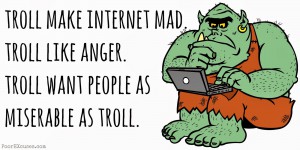Luck plays a greater role in success than usually recognised.
I’ve been lucky in my life. I was lucky to be born in an affluent society of loving and supportive parents. They were well off yet thrifty, and encouraged me in valuable habits. They started me on the clarinet, drove me to weekly private lessons and pushed me to practise daily for several years until I learned to love playing and was self-motivated. They encouraged me in reading and learning, but did not push me to get good grades in school.
I was even lucky when I was called up for military service and decided to leave the US for Australia. It was disruptive at the time, but caused me to rethink my views and led me to a lifetime of activism and research.
In my career I was lucky in getting some jobs and not getting others. Just after finishing my PhD, I applied for a lectureship at a new university and just missed out on what I thought would be an exciting opportunity. Decades later, I happened to talk to the physicist who got the job. He told me, “Brian, you’re so lucky you didn’t end up here!”
Most people’s lives are affected by chance events in many ways, large and small. Yet seldom is this factored into thinking about success and failure because, in meritocratic societies, the assumption is that success is due to talent and hard work and therefore justified.
These thoughts are stimulated by a new book by Robert H. Frank, Success and Luck: Good Fortune and the Myth of Meritocracy. Frank is a prominent economist who has studied the implications of psychology for economics. His earlier books, such as Luxury Fever and The Winner-Take-All Society, are readable and insightful analyses of economic inefficiency caused by wasteful competition.
Success and Luck is part analysis and part personal testament. Frank describes playing tennis and experiencing an episode of sudden cardiac death, which has a 2% survival rate. Frank fully recovered, very much against the odds, because an ambulance happened to be nearby. That he was alive to write his latest book might be said to be a miracle, except that for a mathematically minded economist it was like winning a lottery in survival.
The role of luck in success
Many successful people would rather not acknowledge the role of luck in what they have achieved in life. If what they have and do is due to their talent, drive and hard work, they can feel assured they deserve everything they have. If chance events were important, then perhaps other people, just as talented and hard working but less fortunate, deserve as much.
In academia, luck is involved in obtaining research grants. Much depends on the choice of assessors and on the individuals sitting on granting boards. When success rates are low, there are many good applications near the cut-off: those above the cut-off receive grants and those below do not.
However, as a recipient of a major grant, it is natural to feel the grant is deserved – after all, a lot of work went into the application as well as into all the prior research – and to discount the role of luck. Losers might complain but winners are more likely to feel their award was justified. A grant success then leads to more opportunities to do research, and grants are treated by granting bodies as evidence of high performance, so a single award can lead to a cascade of further grants and research outcomes. Just a tiny bit of luck can make the difference between a stellar research trajectory and a solid but much lower profile career, or even a failure to make the grade as an academic. I’ve known quite a few brilliant scholars who, due to hostile supervisors, biased appointment committees or unsympathetic editors, never had a break and languished their entire careers without even obtaining a permanent position.
Winner-take-all
Frank’s previous studies of winner-take-all markets are relevant here. In the men’s 100-meter final in the 2016 Olympics, the difference between the first and the fourth-place finishers was 0.12 seconds, yet the rewards for the gold medallist, in terms of recognition and endorsements, are far greater than for finishers without medals. You could be fourth best in the world yet receive only a small fraction of the rewards for the first place finisher. Furthermore, you might have had a slower-than-usual start, and the gold-medallist a faster-than-usual start, that made all the difference. That is the potential role of luck.
It used to be that most competitions for career success were localised. If you’re the best lawyer in town, you’ll get many more of the most lucrative cases. However, cheaper travel and communication mean you may now lose out to even better lawyers across the country. The market has expanded: you’re competing against a bigger field, and even a slight advantage can make a huge difference in outcomes.
Let’s say you’re a specialist in corporate mergers. A company worth billions of dollars wants to have the very best lawyers. Because of the huge sums at stake, even a slight advantage is worth paying for. So the salaries of the very best corporate-merger lawyers shoot through the roof.
This winner-take-all process, resulting from the breakdown of previous market barriers, is a prime driver of economic inequality. Frank has written previously of how this happens, and has recommended ways to counter it. In Success and Luck, he draws on this research to make the point that the larger the number of competitors, the more likely it is that luck will play a significant role in determining the winners.
To be clear: every one of the winners in these markets is talented and hard-working. The point is that others are just as talented and hard-working and only lose out due to bad luck. Frank provides tables showing that if outcomes are determined mainly by talent and hard work, with luck contributing only 2%, then when there are many competitors it becomes almost certain that the winner is very lucky and that there are others who are more talented and hard working but less lucky.
Motivation and luck
Frank points out that there can be advantages in discounting the role of luck: it can cause you to try harder. If you believe outcomes are due to hard work, you might be more willing to keep putting in the effort. On the other hand, if hard work isn’t enough and good luck is needed too, is it really worthwhile working quite as hard?
A more important point made by Frank is that if the role of luck is recognised, it becomes more difficult to justify huge differentials in outcomes. If becoming a CEO is partly due to luck – in having the right parents, upbringing, education and opportunities – then why should a CEO have a salary dozens or hundreds of times greater than workers? Some rank-and-file workers, with the same opportunities, might have had what it takes to become a CEO.
Frank thinks that greater awareness of the role of luck may have a beneficial effect in moderating inequality. But there’s a problem. Winners benefit from the belief that their success is due to being superior and so will use their power and influence to help maintain this belief. I would like to believe in Frank’s view but I will wait to hear any leaders give a proper recognition of the role of luck and then try to justify huge levels of inequality.
Frank writes mainly of the US, where economic inequality is extreme, social mobility is limited and yet the belief that commitment and hard work can triumph over adversity remains almost sacred. In many other countries, for example in Western Europe, more generous welfare systems might be seen as recognition that those who are less well off deserve support.
It seems to me there is something different or deeper in the way US policies for disadvantaged people are so much harsher than in most other rich countries, something beyond a lack of recognition of the role of luck. Consider for example someone born with a serious intellectual disability. No one could imagine that such a person’s failure to advance in the meritocracy is anything other than bad luck. So how can a successful entrepreneur justify receiving more than the person with a disability? How does a belief in meritocracy address the issue of people with profound disabilities? This should be the source of cognitive dissonance, so the issue is hardly ever addressed.
Furthermore, anyone could, on any day, become seriously brain-damaged through an accident or stroke, largely as a matter of bad luck. This should be the basis for compassion and support for others, because it could just as easily be yourself.
Frank is tackling the issue of luck at the other end of the spectrum of capabilities, among those who are high achieving. But given that the impact of genetic luck is not seen as an issue for those with serious disabilities, Frank’s hope for change might seem forlorn. However, he found that after conversations about the role of luck, both liberals and conservatives could change their minds. Would they have changed their minds just as readily by raising the issue of serious disabilities?
The progressive consumption tax
In Success and Luck, Frank makes the case for a progressive consumption tax, an alternative to the usual income, goods and other taxes. He and others have been advocating this tax for years. Frank argues that it can painlessly provide the government with revenue to restore US infrastructure and enable people to have the resources to pursue their dreams.
Without going into the details of the tax, suffice to say that its apparent magic is based on addressing status races. As Frank explains, if every rich person has a car, house and wedding worth half as much, they will be just as happy because, in comparison to others, they are just as far ahead. Furthermore, for those who are well off, research shows that extra possessions give little or no extra happiness.
Frank repeatedly uses a revealing example. Which would you rather have: a $150,000 Porsche 911 Turbo and well maintained roads to drive it on, or a $333,000 Ferrari F12 Berlinetta to be driven on roads with potholes? The point is that when public expenditure – on roads, education, health and much else – declines, private wealth cannot compensate.
Frank’s arguments are very good. The question is whether good arguments are enough to bring about a policy change, no matter how rational and socially beneficial for everyone. Frank says that public opinion can shift rapidly, as it has for example on same-sex marriage. As much as I would like to see a policy change that reverses the trend towards greater economic inequality, it seems to me that good ideas need to be taken up by social movements. At the moment the movements for equality need all the help they can get. So if you’ve had a fair bit of success in your life and are willing to accept that you had lucky breaks along the way, then perhaps one way of saying thanks is to join campaigns for greater equality.
A more radical position is the socialist principle of “From each according to their ability, to each according to their needs.” Given that research on altruism shows that helping others can bring great personal satisfaction, often far more than personal achievement, it is possible to develop a rational argument for applying this principle. Wouldn’t the world be different if rational argument – and compassion – were the primary factors in decision-making?
Brian Martin
bmartin@uow.edu.au














































































